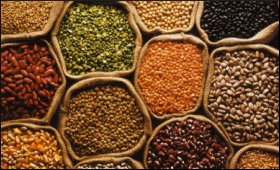|

|
Plan in place to achieve higher pulses production: Minister
|
|

|
|
| Top Stories |
 |
|
|
|
SME Times News Bureau | 26 Oct, 2016
To achieve self-sufficiency in pulses production by 2025, productivity needs to be enhanced to about 1,000 kg per hectare and the government has prepared a plan to achieve that target during FY17 and FY18, Agriculture Minister Radha Mohan Singh said on Tuesday.
Addressing the Members of the Parliamentary Consultative Committee attached to the Ministry of Agriculture here, Singh said a roadmap has been envisaged to achieve production of 20 million tonnes of pulses in 2016-17, 21 mt in 2017-18 and 24 mt in 2020-21, as against 16.47 mt production in 2015-16.
The targets have been set by the government under the centrally-sponsored scheme of National Food Security Mission (NFSM).
Pulses production registered a remarkable increase from 14.76 million tonnes in 2007-08 to a record level of 19.25 mt in 2013-14.
"This could be possible due to a cumulative effect of scientific interventions in the form of development of new varieties and technologies, good weather conditions and policy support," the minister said, according to an official release.
The minister also said that in order to reach self-sufficiency by the year 2025, productivity needs to be enhanced to about 1,000 kg per hectare.
He said that the Indian Council of Agriculture Research (ICAR) is engaged in development of high yielding varieties or hybrids and associated crop production and protection technologies of various pulse crops through coordination with the Indian Institute of Pulse Research, Kanpur, and participation of the state agricultural universities and other institutes.
At the farmers' fields, the frontline demonstrations on pulses recorded productivity gap of 15 per cent due to non-adoption of improved variety of pulses and up to 34 per cent due to non-adoption of the whole package of technology.
It is estimated that by bridging this whole package productivity gap of 34 per cent at the farmers' fields, the national pulses production can be increased to 23.61 mt without bringing any additional area under them and that would be enough to make the country self-sufficient in pulses.
The minister said that it is proposed to cover 500 Krishi Vigyan Kendras through field demonstration for increasing pulses cultivation from the earlier 400 such Kendras. The minister also said that 100 seed hubs have been sanctioned for breeder seeds.
During the discussions, the minister explained that the parameters for drought relief under the National Disaster Relief Fund have been changed, but it is for the states to send a memorandum for seeking drought relief.
The minister also emphasised the need for greater mechanisation in harvesting of pulses and oilseeds to prevent harvest loss.
The Union Agriculture Minister outlined the thrust of the Agriculture Ministry for increasing the productivity of oilseeds and pulses to achieve self-sufficiency.
About oilseeds, the minister said that the ICAR is having research programmes for nine annual oilseeds crops at four commodity-based research institutes.
Singh informed the members that India has a number of oil-yielding species of plant origin, which include the nine annuals, two perennials (oil palm and coconut) and some minor oil bearing species of forest and tree origin.
Officials said the country has to import more than 50 per cent of edible oil. Last year edible oils to the tune of Rs 69,717 crore were imported to meet the domestic demand.
To meet the annual consumption of vegetable oil in the country by 2020 and 2025 -- which is expected to reach 16.43 kg and 16.98 kg per capita, it has been estimated that oilseed production to the tune of 86.84 mt and 93.32 mt, respectively, would be required, the release added.
|
|
|
| |
|
|
|
|
|
|
|
|
|
|
|
|
|
|
| |
| Customs Exchange Rates |
| Currency |
Import |
Export |
US Dollar
|
66.20
|
64.50 |
UK Pound
|
87.50
|
84.65 |
Euro
|
78.25
|
75.65 |
| Japanese
Yen |
58.85 |
56.85 |
| As on 13 Aug, 2022 |
|
|
| Daily Poll |
 |
 |
| PM Modi's recent US visit to redefine India-US bilateral relations |
|
|
|
|
|
| Commented Stories |
 |
|
|
|
|
|
| |
|